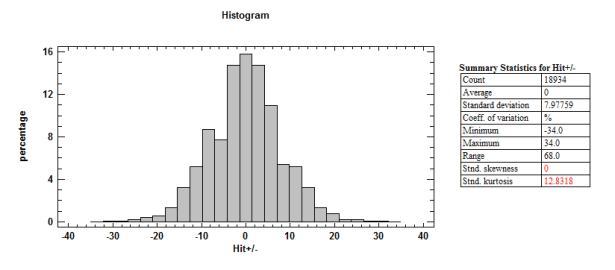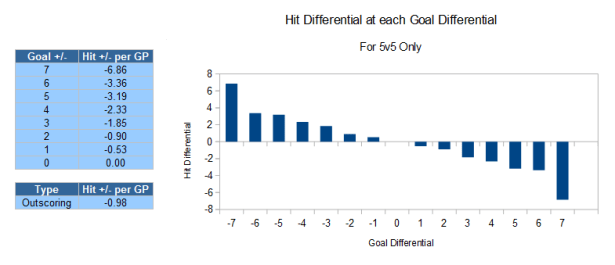The hit statistic rivals the faceoff in praise by some more traditional hockey analysts. Both statistics are also similarly over valued in terms of their impact to the game. There has been work previously shown that the hitting statistic actually has a negative relationship with winning.
I wanted to look into this just a little bit further. I went to War-On-Ice and downloaded data for every NHL game since October 2007. I then cleaned the data and took a little look.
Figure 1: Team in Game 5v5 Hit Differential, October 2007 to January 2015
The graph above is all teams, not just simply home or winning team, so variation, median, mean, and standard skewness all equal zero. The lack of uniformity has to do with the class settings not being perfectly uniform. The data is actually perfectly uniform.
The only real information to gather here is that just over 50% of games have teams within 5 or less hits of each other. So, for the most part, teams tend to be pretty even in terms of hitting at 5v5.
Figure 2: Average Hit Differential at Different Final Scores
Here is where we look a little deeper into the numbers. The numbers show a general trend that out-scoring team tends to be out-hit. However, a general trend doesn’t show how strong that trend is.
Figure 3: Pearson Correlation Coefficient of Different Statistics At 5v5
Interestingly, hit differentials almost have an equal and opposite relationship with goal differentials as shot differentials have with goals.
Fenwick (non-blocked shots) differentials are added as an additional comparison. Fenwick is impacted by score effects more severely than shots, simply due to what teams are doing when the go into defensive shells. Still, it is a positive relationship. Corsi (shot attempt) differentials –not seen– are the most impacted by score effects and essentially have no relationship (Pearson: -0.02).
The point of adding the other frames of reference is to show that, while hits may be influenced by score effects, score effects are not the reason why we see this negative relationship.
(I’m also using this as a reminder that what has the strongest relationship with goals within a single game is not the same as what is predictive of future goals, as we know with Corsi, Fenwick, Shots, and Goal differentials. Corsi is the most predictive generally of future Goals, but Shots has closest relationship within that game.)
Closing Thoughts
Prior to Dellow having taken his work off the internet, there was a study showing how teams tend to win games at a higher rate when out-hit relative to when out-hitting. This included teams well known for their physical play, such as the Los Angeles Kings and the Boston Bruins.
For the statistically inclined, this relationship made sense; the saying “you cannot hit when you have the puck” became a popular saying. Some would argue back that hockey is a physical sport and falsely accuse statistical analysts of not liking hits.
It’s not that hits or hitting is bad; it’s quite the opposite. There are reasons why teams hit after all. It is just that the hit statistic is bad. It doesn’t really tell you anything except the team that is hit more. A team can out hit because they never had the puck, or they can out hit because they are an effective team in the forecheck. More often than not, a team’s hit differential is telling you more about the former than the later.




